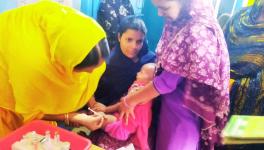Reduced Allocations Show Govt Apathy to Public Health: JSA on Budget 2020-21

The health allocation in the Union Budget 2020-21 has disappointed experts across the country. In the expenditure budget for FY 2020-21, the Ministry of Health and Family Welfare has been allocated Rs 67,111.80 crore, out of which Rs 65,011.80 crore are allocated to the Department of Health and Family Welfare and Rs 2,100 crore are allocated to the Department of Health Research. The allocation for the Department of Health and Family Welfare saw an increase of 3.75% from FY 2019-20. However, according to experts, this increase is not enough to achieve the National Health Policy’s promise of making public healthcare expenditure 2.5% of the GDP by the year 2025.
According to experts, the total allocation for health should have seen a 40% rise in the current year to reach this goal by 2025. The allocations for National Urban Health Mission (NUHM) and Wellness Centres should have seen a 100% rise, and allocation for Jan Aushadhee Yojana should have seen a 400% rise.
The People’s Health Movement in India—the Jan Swasthya Abhiyan (JSA)—a platform of networks and organisations fighting for people’s right to health and universal access to healthcare, has released a statement detailing the implications of this years’ Budget. The statement says, “The apathy of this government towards health of people is clearly depicted by reduced allocations towards Ministry of Health and Family Welfare and Ministry of AYUSH. Although budget allocations have increased in nominal terms to INR 69,234 crore in 2020-21 from INR 66,466 crore promised in the previous budget, the additional INR 2,768 crore does not compensate for rise in prices over the same period. Thus, in real terms, allocations have gone down by 4.3 percent.”
According to JSA, the National Health Mission (NHM) has been continuously neglected in the years of Modi government at the Centre. The allocation for National Rural Health Mission (NRHM) saw a decline of more than Rs 800 crore, when compared to the Revised Estimate (RE) for FY 2019-2020. According to JSA, “When adjusted for inflation, this decline in NRHM allocations is nearly eight percent.”
The Health and Wellness Centres (HWCs) are another key component under Ayushman Bharat, meant to make primary care more comprehensive by expanding from very select services to 12 additional services including treatment Non-Communicable Diseases, has received an allocation of Rs 1,600 crore – the same as in previous year’s Budget. JSA said, “Most of this would go to the recurrent costs of already functioning HWCs which by government figures is less than 15% of the target of 1.5 lakh Sub-Centres upgraded into HWCs by 2022.”
Also read: Union Budget: Government’s Focus on Privatising Healthcare?
The allocations for Reproductive Child Health (RCH) programs, including immunisation have not been increased, even though five more vaccines have been included in the program. The statement said, “Similarly, even without adjusting for inflation, the allocations for communicable diseases and infrastructure maintenance declines. The entire budget for the national urban health mission also stagnates which means in real terms there is a decline in funding for all these essential public services.” It added, “The allocations for AIDS and HIV program and for the autonomous centrally funded hospitals cum teaching centres declines even in nominal terms. What is an apparent increase under the PMSSY (Pradhan Mantri Swasthya Suraksha Yojana), which funds the expansion of new AIIMS, is largely due to repayment of loans.”
This statement pointed out that another major area of concern is the sharp reduction in capital outlays, which are meant for building hospitals and health services and procurement of equipment. In Budget Estimate for FY 2019-2020, the Capital Outlay on Medical and Public Health was Rs 1,675.9 crore. In RE for 2019-2020, it was Rs 1,763.86 crore. This has seen a decline of 43.5% in the current year.
The statement said, “The latest round of NSSO data (75th round) on health shows that more and more people are moving towards public systems as there is a deep rooted recession in rural economy; they are going to hospitals less than earlier as people are finding it difficult to afford health care. In this context it is all the more important that public investment is channelized towards strengthening public systems.”
Also watch: Why Is the Budget Important
Get the latest reports & analysis with people's perspective on Protests, movements & deep analytical videos, discussions of the current affairs in your Telegram app. Subscribe to NewsClick's Telegram channel & get Real-Time updates on stories, as they get published on our website.
























